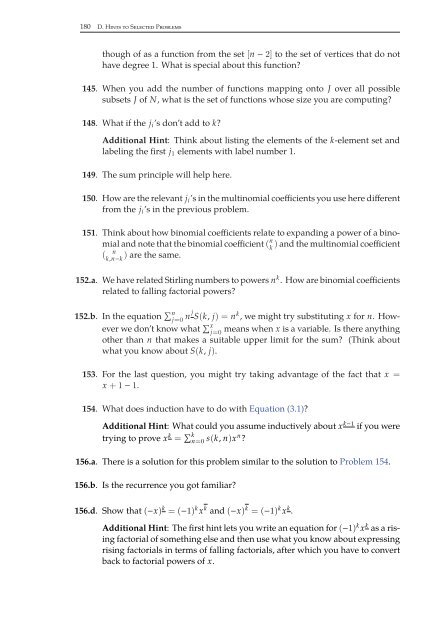Combinatorics Through Guided Discovery, 2004a
Combinatorics Through Guided Discovery, 2004a
Combinatorics Through Guided Discovery, 2004a
You also want an ePaper? Increase the reach of your titles
YUMPU automatically turns print PDFs into web optimized ePapers that Google loves.
180 D. Hints to Selected Problems<br />
though of as a function from the set [n − 2] to the set of vertices that do not<br />
have degree 1. What is special about this function?<br />
145. When you add the number of functions mapping onto J over all possible<br />
subsets J of N, what is the set of functions whose size you are computing?<br />
148. What if the j i ’s don’t add to k?<br />
Additional Hint: Think about listing the elements of the k-element set and<br />
labeling the first j 1 elements with label number 1.<br />
149. The sum principle will help here.<br />
150. How are the relevant j i ’s in the multinomial coefficients you use here different<br />
from the j i ’s in the previous problem.<br />
151. Think about how binomial coefficients relate to expanding a power of a binomial<br />
and note that the binomial coefficient ( n )<br />
k<br />
and the multinomial coefficient<br />
) are the same.<br />
( n<br />
k,n−k<br />
152.a. We have related Stirling numbers to powers n k . How are binomial coefficients<br />
related to falling factorial powers?<br />
152.b. In the equation ∑ n<br />
j=0 n j S(k, j) =n k , we might try substituting x for n. However<br />
we don’t know what ∑ x<br />
j=0<br />
means when x is a variable. Is there anything<br />
other than n that makes a suitable upper limit for the sum? (Think about<br />
what you know about S(k, j).<br />
153. For the last question, you might try taking advantage of the fact that x =<br />
x +1− 1.<br />
154. What does induction have to do with Equation (3.1)?<br />
Additional Hint: What could you assume inductively about x k−1 if you were<br />
trying to prove x k = ∑ k<br />
n=0 s(k, n)x n ?<br />
156.a. There is a solution for this problem similar to the solution to Problem 154.<br />
156.b. Is the recurrence you got familiar?<br />
156.d. Show that (−x) k =(−1) k x k and (−x) k =(−1) k x k .<br />
Additional Hint: The first hint lets you write an equation for (−1) k x k as a rising<br />
factorial of something else and then use what you know about expressing<br />
rising factorials in terms of falling factorials, after which you have to convert<br />
back to factorial powers of x.


















